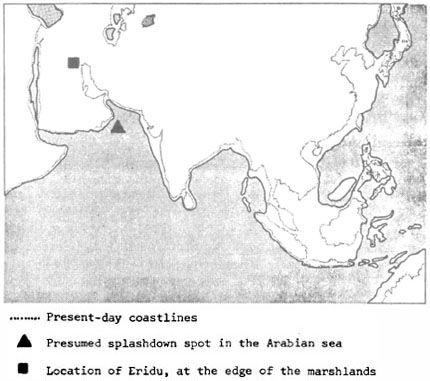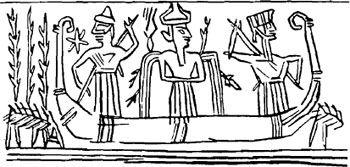The 12th Planet (46 page)
Authors: Zecharia Sitchin
Tags: #Non-Fiction, #Gnostic Dementia, #Fringe Science, #Retail, #Archaeology, #Ancient Aliens, #History

A lonely outpost on an alien planet:
Asia as it probably looked like from the air in the midst of an ice stage. Lower sea levels meant coastlines different from ours today. The Persian Gulf and southern Mesopotamia were patches of muddy ground, lakes and marshlands.

Fig. 127
The first of these cities, ERIDU,
he gave to Nudimmud, the leader.
The second, BAD-TIBIRA,
he gave to Nugig.
The third, LARAK,
he gave to Pabilsag.
The fourth, SIPPAR,
he gave to the hero Utu.
The fifth, SHURUPPAK,
he gave to Sud.
The name of the god who lowered Kingship from Heaven, planned the establishment of Eridu and four other cities, and appointed their governors or commanders, is unfortunately obliterated. All the texts agree, however, that the god who waded ashore to the edge of the marshlands and said "Here we settle" was Enki, nicknamed "Nudimmud" ("he who made things") in the text.
This god's two names—EN.KI ("lord of firm ground") and E.A ("whose house is water")—were most appropriate. Eridu, which remained Enki's seat of power and center of worship throughout Mesopotamian history, was built on ground artificially raised above the waters of the marshlands. The evidence is contained in a text named (by S. N. Kramer) the "Myth of Enki and Eridu":
The lord of the watery-deep, the king Enki ...
built his house....
In Eridu he built the House of the Water Bank....
The king Enki ... has built a house:
Eridu, like a mountain,
he raised up from the earth;
in a good place he had built it.
These and other, mostly fragmentary texts suggest that one of the first concerns of these "colonists" on Earth had to do with the shallow lakes or watery marshes. "He brought ...; established the cleaning of the small rivers." The effort to dredge the beds of streams and tributaries to allow a better flow of the waters was intended to drain the marshes, obtain cleaner, potable water, and implement controlled irrigation. The Sumerian narrative also indicates some landfilling or the raising of dikes to protect the first houses from the omnipresent waters.
A text named by scholars the "myth" of "Enki and the Land's Order" is one of the longest and best preserved of Sumerian narrative poems so far uncovered. Its text consists of some 470 lines, of which 375 are perfectly legible. Its beginning (some 50 lines) is, unfortunately, broken. The verses that follow are devoted to an exaltation of Enki and to the establishment of his relationship with the chief deity Anu (his father), Ninti (his sister), and Enlil (his brother).
Following these introductions, Enki himself "picks up the microphone." As fantastic as it may sound, the fact is that the text amounts to a first-person report by Enki of his landing on Earth.
"When I approached Earth,
there was much flooding.
When I approached its green meadows,
heaps and mounds were piled up
at my command.
I built my house in a pure place....
My house–
Its shade stretches over the Snake Marsh....
The carp fish wave their tails in it
among the small
gizi
reeds."
The poem then goes on to describe and record, in the third person, the achievements of Enki. Here are some selected verses:
He marked the marshland,
placed in it carp and ...–fish;
He marked the cane thicket,
placed in it ...–reeds and green-reeds.
Enbilulu, the Inspector of Canals,
he placed in charge of the marshlands.
Him who set net so no fish escapes,
whose trap no ... escapes,
whose snare no bird escapes,
... the son of ... a god who loves fish
Enki placed in charge of fish and birds.
Enkimdu, the one of the ditch and dike,
Enki placed in charge of ditch and dike.
Him whose ... mold directs,
Kulla, the brick-maker of the Land,
Enki placed in charge of mold and brick.
The poem lists other achievements of Enki, including the purification of the waters of the Tigris River and the joining (by canal) of the Tigris and Euphrates. His house by the watery bank adjoined a wharf at which reed rafts and boats could anchor, and from which they could sail off. Appropriately, the house was named E.ABZU ("house of the Deep"). Enki's sacred precinct in Eridu was known by this name for millennia thereafter.
No doubt Enki and his landing party explored the lands around Eridu, but he appears to have preferred traveling by water. The marshland, he said in one of the texts, "is my favorite spot; it stretches out its arms to me." In other texts Enki described sailing in the marshlands in his boat, named MA.GUR (literally, "boat to turn about in"), namely, a touring boat. He tells how his crewmen "drew on the oars in unison," how they used to "sing sweet songs, causing the river to rejoice." At such times, he confided, "sacred songs and spells filled my Watery Deep." Even such a minor detail as the name of the captain of Enki's boat is recorded. (Fig. 128)

Fig. 128
The Sumerian king lists indicate that Enki and his first group of Nefilim remained alone on Earth for quite a while: Eight
shar's (28,800
years) passed before the second commander or "settlement chief" was named.
Interesting light is shed on the subject as we examine the astronomical evidence. Scholars have been puzzled by the apparent Sumerian "confusion" regarding which one of the twelve zodiacal houses was associated with Enki. The sign of the fish-goat, which stood for the constellation Capricorn, was apparently associated with Enki (and, indeed, may explain the epithet of the founder of Eridu, A.LU.LIM, which could mean "sheep of the glittering waters"). Yet Ea/Enki was frequently depicted as holding vases of flowing waters—the original Water Bearer, or Aquarius; and he was certainly the God of Fishes, and thus associated with Pisces.
Astronomers are hard put to clarify how the ancient stargazers actually saw in a group of stars the outlines of, say, fishes or a water bearer. The answer that comes to mind is that the signs of the zodiac were not named after the shape of the star group but after the epithet or main activity of a god primarily associated with the time when the vernal equinox was in that particular zodiacal house.
If Enki landed on Earth—as we believe—at the end of an Age of Pisces, witnessed a precessional shift to Aquarius, and stayed through a Great Year (25,920 years) until an Age of Capricorn began, then he was indeed in sole command on Earth the purported 28,800 years.
The reported passage of time also confirms our earlier conclusion that the Nefilim arrived on Earth in the midst of an ice age. The hard work of raising dikes and digging canals commenced when climatic conditions were still harsh. But within a few
shar's
of their landing, the glacial period was giving way to a warmer and rainier climate (circa 430,000 years ago). It was then that the Nefilim decided to move farther inland and expand their settlements. Befittingly, the Anunnaki (rank-and-file Nefilim) named the second commander of Eridu A.LAL.GAR ("he who in raintime brought rest.")
But while Enki was enduring the hardships of a pioneer on Earth, Anu and his other son Enlil were watching the developments from the Twelfth Planet. The Mesopotamian texts make it clear that the one who was really in charge of the Earth mission was Enlil; and as soon as the decision was made to proceed with the mission, Enlil himself descended to Earth. For him a special settlement or base named Larsa was built by EN.KI.DU.NU ("Enki digs deep"). When Enlil took personal charge of the place, he was nicknamed ALIM ("ram"), coinciding with the "age" of the zodiacal constellation Aries.
The establishment of Larsa launched a new phase in the settlement of Earth by the Nefilim. It marked the decision to proceed with the tasks for which they had come to Earth, which required the shipping to Earth of more "manpower," tools, and equipment, and the return of valuable cargoes to the Twelfth Planet.
Splashdowns at sea were no longer adequate for such heavier loads. The climatic changes made the interior more accessible; it was time to shift the landing site to the center of Mesopotamia. At that juncture, Enlil came to Earth and proceeded from Larsa to establish a "Mission Control Center"—a sophisticated command post from which the Nefilim on Earth could coordinate space journeys to and from their home planet, guide in landing shuttlecraft, and perfect their takeoffs and dockings with the spaceship orbiting Earth.
The site Enlil selected for this purpose, known for millennia as Nippur, was named by him NIBRU.KI ("Earth's crossing"). (We recall that the celestial site of the Twelfth Planet's closest pass to Earth was called the "Celestial Place of the Crossing.") There Enlil established the DUR.AN.KI, the "bond Heaven—Earth."
The task was understandably complex and time-consuming. Enlil stayed in Larsa for 6
shar's
(21,600 years) while Nippur was under construction. The Nippurian undertaking was also lengthy, as evidenced by the zodiacal nicknames of Enlil. Having paralleled the Ram (Aries) while in Larsa, he was subsequently associated with the Bull (Taurus). Nippur was established in the "age" of Taurus.
A devotional poem composed as a "Hymn to Enlil, the All-Beneficent" and glorifying EnliI, his consort Ninlil, his city Nippur, and its "lofty house," the E.KUR, tells us much about Nippur. For one thing, Enlil had at his disposal there some highly sophisticated instruments: a "lifted 'eye' which scans the land," and a "lifted beam which searches the heart of all the land." Nippur, the poem tells us, was protected by awesome weapons: "Its sight is awesome fear, dread"; from "its outside, no mighty god can approach." Its "arm" was a "vast net," and in its midst there crouched a "fast-stepping bird," a "bird" whose "hand" the wicked and the evil could not escape. Was the place protected by some death ray, by an electronic power field? Was there in its center a helicopter pad, a "bird" so swift no one could outrun its reach?
